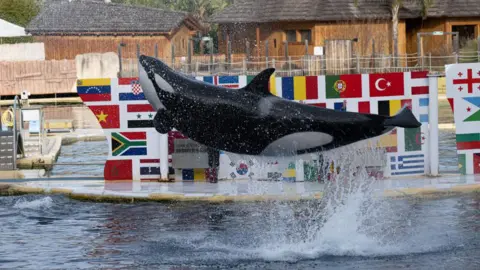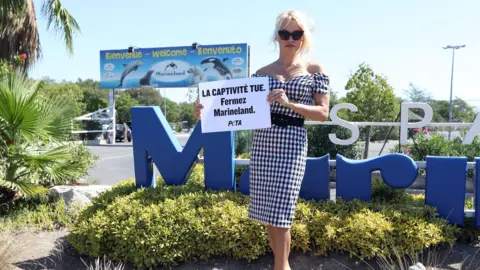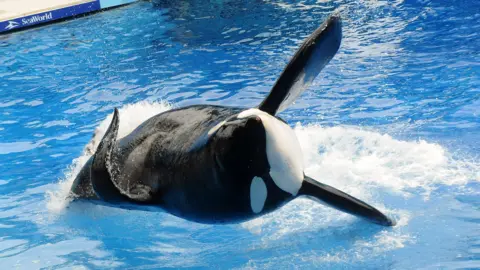 AFP
AFPThe fate of two killer whales is uncertain after the closure of a marine zoo in France on Sunday.
Campaigners and zoo managers are at odds over what should happen to the killer whales, with the French government already blocking a proposal to rehome them.
Last month, Marineland Antibes, located near Cannes on the French Riviera, said it would close for good on January 5 following new animal welfare laws.
Legislation banning the use of dolphins and whales in marine zoo shows was passed in 2021 but comes into effect next year.
Marineland, which describes itself as the largest of its kind in Europe, currently holds two killer whales – Wikie, 23, and her 11-year-old son Keijo.
Managers say shows featuring orcas and dolphins attract 90% of Marineland's visitors – and that without it the business is not viable.
Several destinations for the whales have been proposed, but there is disagreement over where they should go and what should happen to them.
Most experts agree that releasing the two whales, which are specifically Icelandic killer whales, into the wild would not be appropriate, as both were born in captivity and lack the skills to survive.
“It's a bit like taking your dog out of the house and sending him into the forest to live free as a wolf,” says Hanne Strager.
In 2023 the marine biologist published The Killer Whale Journals, detailing her decades-long interest in ocean predators and how they behave.
“Those whales that have spent their entire lives in captivity, their closest relationship is with humans. They are the ones who provided them with food, care, activities and social relations.
“Orcas are highly social animals, as social as we (humans) are, and they depend on social connections. They've made these connections with their trainers … They depend on people, and that's the only thing they know.”
 AFP
AFPA deal to send Wikie and Keijo to a marine zoo in Japan, backed by Marineland managers, sparked outrage among activists who said they would be treated worse.
Last November, the French government blocked the deal, saying animal welfare laws in Japan were lax compared to those in Europe and that the 13,000 km (8,000 mile) journey would cause stress to the orcas.
Another option is to send them to a Spanish marine zoo in the Canary Islands.
Tenerife's Loro Parque meets European animal welfare standards, but campaigners fear Wikie and Keijo will still be forced to play there.
There have also been several killer whale deaths there in the past few years.
A 29-year-old male named Keto died in November, and three other killer whales died there between March 2021. and September 2022.
Loro Parque says that scientific studies of these three killer whales by the University of Las Palmas de Gran Canaria show that death was inevitable.
Catherine Wise of the charity World Animal Protection (Wap) told the BBC: “It would be disastrous for Wikie and Keijo to end up in another entertainment venue like Loro Parque – from one whale prison to another.”
Wap want the killer whales to be rehoused in an adapted ocean bay.
“(We and) many others have called on the French government to do everything possible to facilitate the movement of orcas to sanctuary off the coast of Nova Scotia.”
“We will close the gulf for them”
The organization, which hopes to build the facility in eastern Canada, says it will be able to attract funding if it gets a commitment from the French government to send the two whales there.
The Whale Sanctuary Project (WSP) proposes to close a 40-hectare (98-acre) area of seawater with nets.
Wikie and Keijo were then able to use the large body of water, with human support from vets and social workers, for the rest of their lives.
The average lifespan of a male orca is about 30 years, according to the US National Oceanic and Atmospheric Administration. Females usually live about 50 years.
“Life in the sanctuary will be as close as possible to what they would experience growing up in the ocean,” WSP says. “It will be a new life that it's going to make up for so much of what it was before.”
A similar project has been done before.
Keiko, the killer whale who starred in the 1993 film Free Willy, was rescued from captivity in 1996 before being washed into a bay in Iceland in 1998.
Unlike Wikie and Keijo, he was born in the wild and was able to relearn some of the necessary survival skills while living in the bay for four years.
Eventually he left with a group of killer whales he had joined and swam to Norway, where he died in 2003 after infection.
Strager warns that the proposed refuge may seem as foreign to Wiki and Keijo as the open ocean.
“We have this concept that animals enjoy freedom in the same sense that we do, 'now they're free and they're going to like it.'
“We don't know if they see freedom the same way… Will they be scared because it's so different from what they're used to?” I don't know.'
She told the BBC: “I don't think there are any good solutions for animals that have been kept in captivity all their lives.”
 AFP
AFPMore than 4,000 animals will be relocated from Marineland, which was founded in 1970. by Count Roland de la Poppe.
He was an award-winning fighter pilot who fought in World War II before settling in the plastics industry and opening Marineland because of his interest in marine life.
The closure of his passion project is the latest step in a campaign targeting marine zoos that has gathered momentum over the past 15 years.
Actress Pamela Anderson called for Marineland to be closed in 2017. and held a protest outside its entrance with the sign “captivity kills”.
In 2013 the documentary Blackfish details how an orca named Tilikum killed trainer Dawn Brancheau after a show at SeaWorld Orlando in 2010.
He grabbed her and dragged her into the water, where he tore off her arm and drowned her.
The film also outlines how Tilikum is also involved in the deaths of two other people.
Researchers interviewed in the film claim that killer whales captured from the wild and trained to play become violent in captivity.
 Getty Images
Getty ImagesThe number of visitors and financial revenue at SeaWorld suffered after the documentary and in 2016 they stopped their captive breeding program.
They rejected calls to release their remaining orcas into the wild, saying they would likely die if left to fend for themselves.
Eighteen months ago, they opened a new SeaWorld in the United Arab Emirates, the first SeaWorld outside the US.
The new facility in Abu Dhabi is a $1.2bn (£966m) venture with state-owned entertainment company Miral and features the world's largest aquarium.
There aren't any killer whales here, but to the dismay of the activists, the dolphins still are.
Wap helped Expedia no longer sell vacations featuring captive dolphin shows, and they want other travel companies to do the same.
“Blackfish was more than a hit—it was a phenomenon,” writes scholar Naomi Rose in a Wap report. “I am convinced that this has pushed Western society past the tipping point on the topic of captive cetaceans.”

